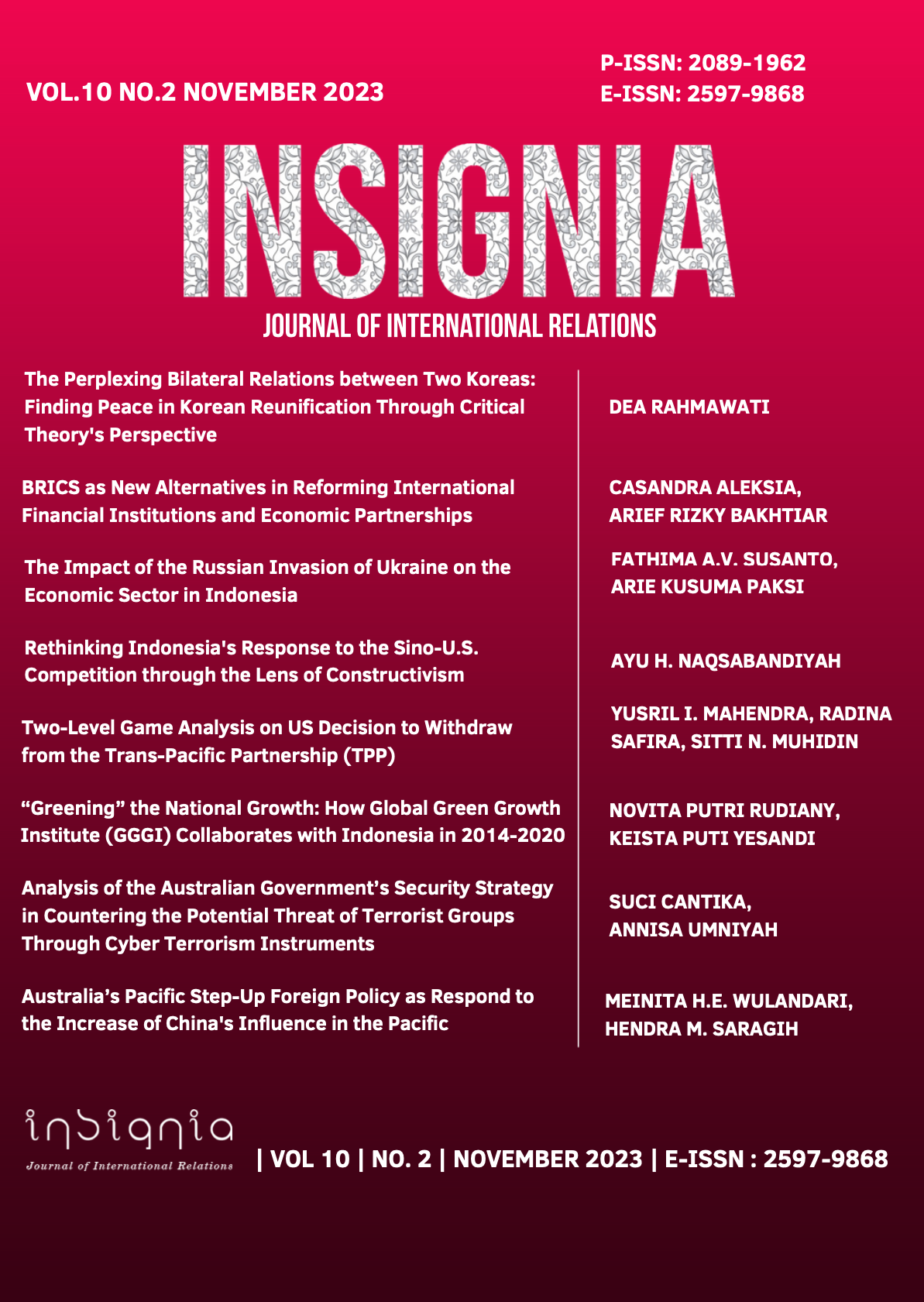BRICS as New Alternatives in Reforming International Financial Institutions and Economic Partnerships
Abstract
The article aims to examine the role of the combined economies of Brazil, Russia, India, China and South Africa (BRICS) in reforming the international financial institutions and economic partnerships. BRICS offers new values and serves as alternatives for both its current and prospective members in having an equal access to source international investments.. The arguments revolve around BRICS’ strategies to create an effective development program that not only revolves around their own growth agendas. In addition, BRICS have greater goals on establishing global trade relations and economic partnerships through the New Development Bank (NDB) and Contingent Reserve Arrangement (CRA) among many others. The discussion also focuses on other several key research areas related to BRICS’ efforts in promoting economic partnerships and the overall impacts of the partnerships. By emphasizing the shared interests of developing nations and emerging markets, giving high-quality economic and trade development priority, promoting true multilateralism, and highlighting opportunities in emerging fields to contribute more to an open global economy, this paper offers recommendations for BRICS’ future development. This study uses qualitative method to achieve the objectives of this study. The most fundamental characteristic of qualitative research is seeing the problems studied from the perspective of the subjects studied.
Keywords: BRICS, economic cooperation, financial institution, partnership
References
Arapova, E. (2018). Determinants of household final consumption expenditures in asian countries: A panel model, 1991-2015. Applied Econometrics and International Development, 18, 121-140.
Biermann, F., Betsill, M. M., Gupta, J., Kanie, N., Lebel, L., Liverman, D. Schroeder, H., & Siebenhüner, B. (2009). Earth System Governance: People, Places and the Planet. Science and Implementation Plan of the Earth System Governance Project. Bonn: The Earth System Governance Project.
Agarwal, M. & Kumar, S. (2023). BRICS Countries’ Increasing Role in the world economy, Including Institutional
Innovation. BRICS Journal of Economics, 4(2), 173-191. https://doi.org/10.3897/brics-econ.4.e99451
BBC. (2021, 16 April). “China's economy grows 18.3% in post-Covid comeback.” Accessed from https://www.bbc.com/news/business-56768663.
BRICS. (2023). “About Us: History.” Accessed from https://www.ndb.int/about-us/essence/history/.
BRICS. (2022a). “Previous Summits.” Accessed from http://brics2022.mfa.gov.cn/eng/gyjzgj/ljldrhwjj/.
BRICS. (2022b). “Xi Focus: Xi Pumps More BRICS Power into Global Economic Governance.” Accessed from http://brics2022.mfa.gov.cn/eng/gyjzgj/ljldrhwjj/.
BRICS Information Centre at the University of Toronto. (2020). “Strategy for BRICS Economic Partnership 2025.” Accessed from http://www.brics.utoronto.ca/docs/2020-strategy.html.
Cynthia, R, Armijo, L., and Katada, S. (2017). Introduction: The BRICS as a Club, The BRICS and Collective Financial Statecraft. New York: Oxford Academic. https://doi.org/10.1093/oso/9780190697518.003.0001
Daldegan, W., & Carvalho, C. (2021). The Status of the BRICS, 20 Years Later. E-International Relations. Accessed from https://www.e-ir.info/2021/11/18/opinion-the-status-of-the-brics-20-years-later/.
European Commission. (2018). “Developments and Forecasts of Growing Consumerism.” Accessed from https://knowledge4policy.ec.europa.eu/foresight/topic/growing-consumerism/more- developments-relevant-growing-consumerism_en.
Hooijmaaijers, B. (2021). Understanding Success and Failure in Establishing New Multilateral Development Banks: The SCO development bank, the NDB, and the AIIB. Asian Perspective, 45(2), 445–467.
Iqbal, B. A., & Rahman, M.N. (2017). BRIC(S) as an Emerging Block? The Challenge of BRIC Multinationals. Progress in International Business Research, 11, 227-245.
Hofman, B. & Srinivas, P. S. (2022). New Development Bank’s Role In The International Financial Architecture. EAI Background Brief No. 1660. Singapore: National University of Singapore.
Kralikova, K. (2014). BRICS: Can a Marriage of Convenience Last? European View, 13, 243–250. https://doi.org/10.1007/s12290-014-0326-2.
Li, Jingcheng & Pogodin, Sergey. (2020). BRICS Economic Cooperation Factors in Global Governance. IOP Conference Series: Materials Science and Engineering. 940. 012029. https://doi.org/10.1088/1757-899X/940/1/012029.
Luckhurst, J. (2013). Building Cooperation Between the BRICS and Leading Industrialized States. Latin American Policy, 4(2), 251-268.
Mostafa, G. (2015). The Rise of the BRICS and Their Challenge to the G7. International Journal of Emerging Markets, 10(1), 156-170.
Narlikar, A. (2013). India Rising: Responsible to Whom? International Affairs, 89(3), 595-614.
New Development Bank (NDB). (2021). “Annual Report 2021: Expanding Our Reach and Impact.” Accessed from https://www.ndb.int/annual-report-2021/pdf/NDB_AR_2021_complete.pdf.
New Development Bank (NDB). (2022a). “General Strategy for 2022–2026: Scaling Up Development Finance for A Sustainable Future.” Accessed from https://www.ndb.int/wp-content/uploads/2022/07/NDB_StrategyDocument_Eversion-1.pdf.
New Development Bank (NDB). (2022b). “NDB President Marcos Troyjo Reported to the 14th BRICS Summit.” Accessed from https://www.ndb.int/press_release/ndb-president-marcos-troyjo-reported-to-the-14th-brics-summit/.
Pandey, A. (2007). Communalism and Separatism in India: An Analysis. Journal of Asian and African Studies, 42(6), 533-548.
Porto, F. & Donnellon-May, G. (2023, 27 April). “Shaky foundations for the New
Development Bank.” The Lowy Institute. Accessed from https://www.lowyinstitute.org/the-interpreter/shaky-foundations-new-development-bank.
Putri, F. M., & Santoso, M. P. T. (2023). BRICS Diplomacy: Building Bridges for Global Cooperation. Politics and Humanism, 2(1), 10-21. https://doi.org/10.31947/jph.v2i1.27197
PricewaterhouseCoopers (PwC). (2017). “The Long View How Will the Global Economic Order Change by 2050?” Accessed from https://www.pwc.com/gx/en/world-2050/assets/pwc-the-world-in-2050-full-report-feb-2017.pdf.
Renard, T. (2009). BRIC in the World: Emerging Powers, Europe, and the Coming Order. EGOMONT Paper 31. Brussels: Royal Institute of International Relations, Academic Press.
Robinson, S. & Thierfelder, K. (2002). Trade Liberalisation and Regional Integration: the Search for Large Numbers. Aust J Agric Resour Econ, 46(4), 585–604. https://doi.org/10.1111/1467-8489.t01-1-00057
Shameem, C. & Jayaprasad, K. (2020). The Evolution of BRICS in International Political Economy. American Review of Political Economy, 15(1), 1-19. https://doi.org/10.38024/arpe.sj.6.28.20
The Economic Times. (2015). “New Development Bank's First Loan Will be in Chinese Currency Kamath.” Accessed from https://economictimes.indiatimes.com/news/economy/finance/new-development-banks-first-loan-will-be-in-chinese-currencykv-kamath/articleshow/48199704.cms?from=mdr.
The Economic Times. (2023). “What is ‘BRICS’?” Accessed from https://economictimes.indiatimes.com/definition/Bri
Varela, A. H. & Delgado, R. G. M. (2019). The BRICS in the Contemporary Global Order: Objectives, Capabilities, and Limitations. Otoritas: Jurnal Ilmu Pemerintahan, 9(2), 89-106.
XinhuaNet. (2020). “BRICS countries launch partnership innovation center in Xiamen.” Accessed from http://www.xinhuanet.com/english/2020-12/09/c_139574138.htm.

This work is licensed under a Creative Commons Attribution-NonCommercial-ShareAlike 4.0 International License.
1. The author retains copyright and grants the journal the right of first publication with the work simultaneously licensed under a Creative Commons attribution license that allows others to share the work within an acknowledgment of the work’s authorship and initial publication of this journal.
3. Authors are permitted and encouraged to post their work online (e.g., in institutional repositories or on their websites) before and during submission, as it can lead to productive exchanges and earlier and more extraordinary citations of published works.


.png)


